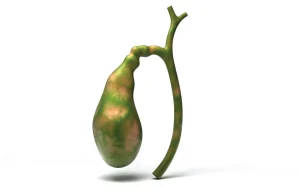GALLBLADDER
GALLBLADDER

What is the gallbladder?
The gallbladder is a small, pear-shaped organ situated beneath the liver in the upper abdomen. Its primary function is to store and concentrate bile, a digestive fluid produced by the liver.
When we consume fatty foods, the gallbladder contracts, releasing bile into the small intestine to aid in the digestion and absorption of fats. It plays a crucial role in the digestive process, helping to emulsify fats and promote efficient nutrient absorption in the intestines.
Despite its importance, the gallbladder can be surgically removed without significantly affecting digestion.
The gallbladder serves several important functions in the digestive process:
- Bile storage: The primary function of the gallbladder is to store bile produced by the liver. Bile is a yellow-green fluid that contains bile salts, which aid in the digestion and absorption of dietary fats.
- Bile concentration: While in the gallbladder, bile is concentrated by removing water and electrolytes, making it more potent and effective in breaking down fats.
- Bile release: When a meal containing fats is consumed, the gallbladder contracts, releasing stored and concentrated bile into the small intestine. This helps emulsify and digest dietary fats, allowing for their absorption in the intestines.
- Digestive aid: Bile is essential for the digestion of fats and fat-soluble vitamins (A, D, E, and K). It helps break down large fat globules into smaller droplets, increasing their surface area for enzymes to act upon and facilitating absorption.
The gallbladder is part of the biliary system, which includes several other organs and structures:
- Liver: The liver produces bile continuously and releases it into small channels called bile ducts.
- Bile ducts: These are a network of channels that transport bile from the liver to the gallbladder and, ultimately, to the small intestine. There are two main bile ducts: the common hepatic duct and the cystic duct.
- Common hepatic duct: This duct carries bile from the liver to the gallbladder and can also transport it directly to the small intestine when the gallbladder is not actively releasing bile.
- Cystic duct: The cystic duct connects the gallbladder to the common hepatic duct. It is through this duct that bile flows from the gallbladder to the small intestine during digestion.
- Pancreas: Although not directly part of the biliary system, the pancreas plays a role in digestion by producing digestive enzymes. The pancreatic duct joins the common bile duct just before it enters the small intestine. Together, they release digestive enzymes and bile into the small intestine to aid in digestion.
- Small intestine: Bile is released into the small intestine, specifically the duodenum, where it emulsifies fats, making them more accessible for digestion by pancreatic enzymes and absorption into the bloodstream.
- Sphincter of Oddi: This muscular valve controls the release of bile and pancreatic enzymes into the small intestine. It regulates the flow of digestive fluids from the common bile duct and pancreatic duct into the duodenum.
- Gallstones: Gallstones are solid particles that can form in the gallbladder due to the crystallisation of substances found in bile, such as cholesterol and bilirubin. They can occasionally cause blockages and lead to gallbladder-related issues.
In summary, the gallbladder is a critical component of the digestive system, storing and releasing bile to aid in the digestion and absorption of fats in the small intestine. It works in conjunction with the liver, bile ducts, pancreas, and other digestive organs to ensure the efficient processing of dietary fats.









